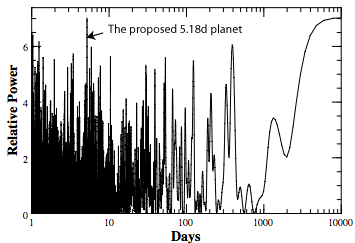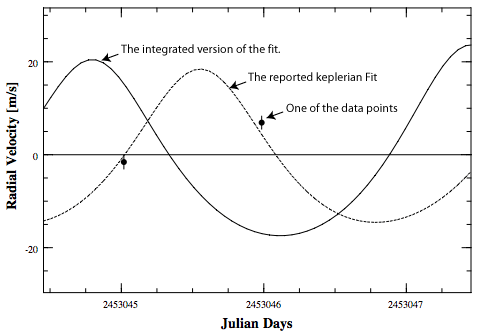
Image Source.
There’s a provocative paper up on the astro-ph today. Ignasi Ribas and two collaborators are reporting the “possible discovery” of a 4.8 Earth mass planet in an exterior 2:1 mean motion resonance with the transiting hot Neptune Gliese 436b. Planet four three six b is the well-known subject of great consternation, great scientific value, and many an oklo.org post. (For the chronological storyline, see: 1 (for background), 2, 3, 4, 5, 6, 7, 8, 9, and 10.)
Here’s the basic idea. Ribas et al. note that a single-planet fit to the Maness et al. (2007) radial velocity data set (which is listed as gj_436_M07K on the systemic console) has a peak in the residuals periodogram at P~5.1866 days:

Using this periodogram peak as a starting point, they get a keplerian 2-planet fit that lowers the reduced chi-square from ~4.7 to ~3.7. They then point out that this detection can potentially be confirmed by measuring variations in transit timing. In their picture, the presently-grazing transit has come into visibility only within the last 2.5 years or so, as a result of orbital precession. The transit light curve should thus be showing significant variations in duration as well as deviations from a strictly periodic sequence of central transit times.
This will be a huge big deal if the claim holds up. For starters, it’ll provide a natural explanation for Gl 436b’s outsize eccentricity. And everyone’s been on the lookout for a strongly resonant transiting system with a short orbital period. For the time being, though, I’m withholding judgment. As a first point of concern, Ribas et al. are presenting a keplerian fit to the radial velocities. Yet for the orbital configuration they are proposing, it’s absolutely vital to take planet-planet interactions into account. One can see this by entering their fit into the console. (Use a mean anomaly at the first RV epoch 2451552.077 for planet b=40.441 deg, corresponding to their reported time of periastron of Tp_b=HJD 2451551.78, and a mean anomaly for planet c=268.14 deg, corresponding to their reported value of Tp_c=HJD 2451553.4.) One can also dial in a long-term trend if one wants, but this isn’t necessary. Once the fit is entered, the reduced chi-square is 3.7. Activate integration. (Hermite 4th-order is the faster method.) When the planets are integrated, their mutual interactions utterly devastate the fit, driving the reduced chi-square up to 85.018. Using the zoomer and the scroller, you’ll see that the integrated radial velocity curve and the keplerian curve start off as a good match, but then rapidly get completely out of phase.

In order to examine the plausibility of a two-planet fit in 2:1 mean motion resonance, one needs to fit the radial velocity data with integration turned on. It is also important to include the existing transit timing data in the fit (and to do this, it’s best to use the most recent, so-called unstable version of the console). Over at Bruce Gary’s amateur exoplanet archive (AXA), there are now three transit timing measurements listed, with the latest obtained by Bruce himself this past New Years Eve. The HJD measurements of central transit should be added to the gj436.tds file, along with the HJD 2454280.78149 +/- 0.00016 central transit time measured by Spitzer.
Ideally, the Spitzer secondary transit timing data should also be included, but at the moment, the distribution version of the console does not have the capability to incorporate secondary transit measurements. One approach would be to get a self-consistent fit, and then see whether the epoch of secondary transit matches that observed by Spitzer.
Have fun…

This system is a good example of why the top two peaks in the 1-10 day range should be displayed in the periodograms. I get a peak at 1.1997 days which is much stronger than the ~5 day peak, which is visible in the graph but sufficiently narrow to be quite hard to hit.
Hmmm… it seems that the ~5-day planet is hard to find. However quite a few of the fits uploaded contain a 53-day planet of around 12-13 Earth masses. Would such a planet be able to cause the observed perturbations and maintain the eccentricity of planet “b”?
Pingback: Centauri Dreams » Blog Archive » A ‘Super Earth’ Around GJ 436?
Hi Andy,
Indeed. I see no indication that this claimed planet is real, but it’ll be interesting to see whether the self-consistent fit has both resonant arguments librating.
Occams razor works against the idea that Butler et al. missed the transit which then, amazingly, precessed into view. The Butler et al. photometry was based on phase-folded data, which, when low-amplitude signals are present, is notoriously tough to deal with. In all likelihood, the transit signal is actually present in the clump of low points on the Butler et al. plot, muddled perhaps by long-term systematic errors in the time series.
The timing data collected to date shows no evidence of planet-planet induced timing variations.
That said, Gliese 436 has surprised us in the past….
(Comment edited slightly 1/24/08. The original version was overly harsh.)
There’s another transit curve on the AXA site dated February 1 2008. These are the numbers I’m getting to put into the TDS file. I’ll add an error estimate of 0.001 to the two transits that lack numbers.
2454222.616 0.001
2454238.47926
2454251.6993
2454280.78149 0.00016
2454465.8498 0.00179
2454497.5790 0.0025
Are these the correct numbers? I’ll admit I’m not sure about the distinction between JD and HJD or mid and ephem numbers.
Chris